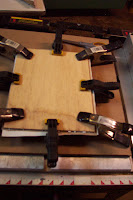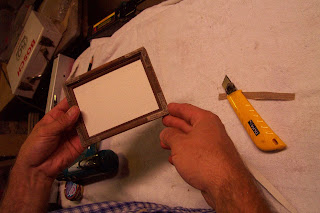A few years ago a local Cincinnati
frame company closed up shop after a pretty substantial run. Luckily they are now selling off the remaining frames. Contact them to set up an appointment if you would like to look through their stock. You can pick up an 11 x 14 for $20 and a 30 x 40 inch frame for $60. The frame selection is very random, and the sizes are often odd (meaning, not standard sizes). Many of the frames have a very nice design and most are unfinished so you can work them up how ever you like.
As the frames are odd sizes and non-square shapes you will have to cut panels to fit these frames. So I thought I would discuss how I make my own panels, what type of panels I like to paint on, and how to make them suitable for painting.
Of course, you can stretch a canvas any size if you buy the right sized stretcher bars, but for anything smaller than 16 x 20 I will often make a panel.
If you are painting your picture on wood, it needs to be protected from the oil paint somehow. Oil paint has a tendency to eat away at organic materials. It will eventually destroy paper and cloth unless you somehow protect from the paint. The traditional choice is to gesso the wood or canvas. I have painted on oil primed wood but often find the surface too slick. After a bit of painting it feels like you are working on glass, which I find very unpleasant. I like some tooth to the surface. The best surface is oil primed canvas. The texture allows you to work in layers, build up heavy, thick paint, and is great for subsequent reworkings. I have recently done some paintings on the roughest linen I can find that is close to burlap in texture. It makes me giggle like a school girl. It is just a wonderful surface that can look almost like a pastel drawing.
SO MR. LUSCHEK, HOW DO I MAKE AMAZING PANELS JUST LIKE YOURS?
First things first
Cut your Panel to Size:
Make sure the panel fits the frame. I buy plywood from the hardware store, or get left over pieces from a local cabinet shop. Often they have small pieces of 1/4 inch plywood that is of no real use to them, but are great for painting on. A good basic plywood to purchase at the hardware store is birch. Cabinet shops will often have finer woods from finish cabinetry. I do like cherry plywood, but almost any type of wood will do. Make sure it has a smooth finish.
I have table saw, that allows me to cut the panels to the shape I need. Hardware stores are selling the panels in 2' x 4' sizes that allow for easier handling.
If there is a arch to the frame, or it is an oval, I will trace the size from inside the frame and cut it out with my jig saw. This could be used to cut square pieces as well. You can pick a saw like this up for a pretty reasonable price. When cutting, I usually cut the panel at least 1/8" smaller than the inside lip of the frame.
Finishing the Panel- Shellac
You can paint directly on the wood if you coat it with a finish. I often use shellac. I will get an amber shellac from the hardware store and just coat the panel. It gives it a nice warm tone. This will result in a glossy and slick surface, that I am often not fond of, but I do occasionally do it.
Above is a painting on a 3" x 5" painting done on cherry plywood with an amber shellac finish.
Making Canvas Boards:
My preferred method is to glue canvas on the plywood. I really enjoy working on
oil primed Belgian Linen. It is of high quality and is like painting on butter (please note, that is a figure of speech- I do not recommend actually painting on butter). I also really enjoy Belgian beer- I do not recommend that you drink while making your canvas panels.
When I was researching online about how to glue up canvas panels,
Yes Paste was often suggested.
Just say NO to Yes Paste! It was a complete disaster. I used it quite a bit. I had trouble with the canvas separating from the panel, bubbling up to complete separation. Do not use this product for gluing up panels.
Then I discovered
Miracle Muck. It is wonderful stuff. It goes on easier, is less messy, and most importantly, it tightly glues the canvas to the panel. One exciting feature is that Miracle Muck is heat activated, so if your painting begins to delaminate, an iron could be used to secure the canvas back to the panel.
First, I cut out a piece of canvas slightly bigger than the panel, and then generously apply glue to the panel.
Smooth out the glue nice and even, apply more glue as needed.
Lay the canvas on the glued panel and either gently roll it out smooth. I have a rubber roller I use for this purpose.
I try to glue up multiple panels of the same size so I can apply pressure to them all at once. I put the two or more panels together, so the canvas sides are together. Basically, the two glued panels are placed face to face, and pressure is applied either with a weight or using spring clamps as shown. This way the pressure is on the back and will not dent the canvas. I have also placed the panel face down on a clean flat surface and set a heavy object on the back. Let them sit overnight till the glue is dry.

Above you can see the glued up oval panels cut for the small oval frame.
Trim The Canvas
After the glue is dry I use a blade and trim the canvas flush to the panel. I try to slowly and carefully pull the blade down the side. I cut so I can see the how close I am to the panel, and do so front to back so the force of the blade pushes the canvas against the ply. Do your best to not disembowel yourself. Blood and innards will stain the canvas.
Now you have a nice trimmed panel for your frame.
See how nice it fits. Shown in a small, unfinished Castner frame.
Now you just have to paint something on that panel that will amaze all of your friends.
An extra tip, when painting on a small panel I highly recommend that you use a pencil and trace the inside edge of the frame on the panel. Remember there is often a 1/4 " lip on the frame. If you are painting a 3 x 5 panel that is a substantial portion of the picture. So make sure you are designing inside the frame, and not to the edge of the panel that will be covered by the frame. I have had few tantrums after realizing that some beautiful passage that I painted on the edge of a painting is obscured by the frame.
I am planning on doing a workshop on Frame Finishing for Artists. It will be sometime in the fall at the Castner Warehouse. Let me know if you are interested. I will post more details at a later date.
One added note to this post- beware of the shipping costs if you order this product! I ended up paying almost as much in shipping as I did for the glue. I let out a blood curdling scream when I saw that.
Just a warning.










































